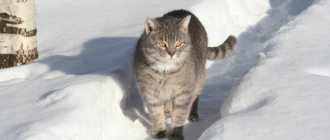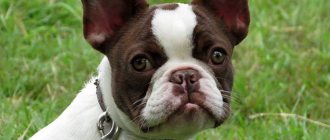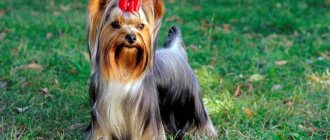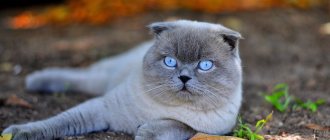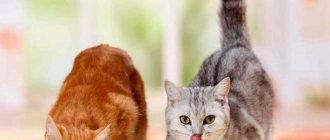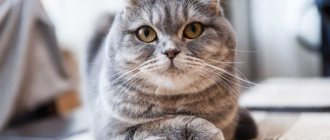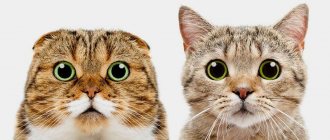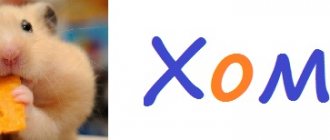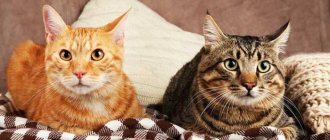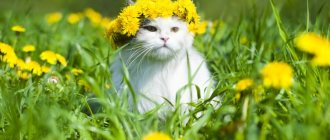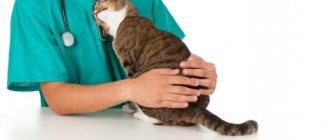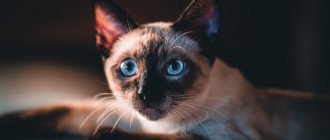- Pets
- >>
- Cat breeds
* Here is a photo of a typical representative of the Scottish Fold cat breed . You can send us photos of your animals by email, and we will post them on the website. Don't forget to send your pet's name.
Other breed names:
Scottish fold
Video
* We invite you to watch a video about the Scottish Fold cat . In fact, in front of you is a playlist in which you can select and watch any of 20 videos about a given cat breed by simply clicking on the button in the upper right corner of the window. In addition, the material contains quite a lot of photos. By looking at them you can find out what a Scottish Fold cat looks like.
In this article:
|
Where can I buy
Before purchasing a kitten, it must be examined, and quite carefully, since in the future you may encounter cartilaginous anomalies. If the kitten has weak joints, bowed legs, or hardening of the joint tissues, then there is a high probability that problems will not be long in coming.
Moreover, if you buy an animal in a special nursery, the risk of purchasing a sick kitten is much less than when buying on the market or from some private owner who breeds this breed.
Nowadays in Russia there are a sufficient number of legal nurseries that practice breeding the Scottish Fold breed. They can be found in almost all major cities throughout Russia.
A kitten of this breed can be bought for a maximum of 5 thousand rubles secondhand, but in a nursery you will have to pay three times more for it. But the kitten has a pedigree, a veterinary passport, and a purchase and sale agreement. The upper threshold of pricing depends on the purebred, unique color of the kitten, as well as on the authority of the nursery.
History of the origin of Scottish Fold cats
The Scottish Fold breed appeared relatively recently, about 50 years ago. The ancestors and main relatives of Scottish Fold cats are British Shorthair cats. Despite the fact that the ancestors of animals of this breed were short-haired, the first kittens of this breed had mostly long hair. The first kitten known to the world was bought by Valery Ross in 1961 on a farm in the Scottish city of Tayside.
The kitten was unique in its own way; it had unusual ears that hung forward. The kitten's mother, the cat Susie, was the very first representative of this breed and gave such beautiful offspring. In 1973, kittens of this breed went to the famous cat breeder Sally Wolfe Peters, and this breed attracted public attention.
In 1978, cats of the Scottish breed participated in cat shows and received the status of the Cat Fanciers' Association. More and more people wanted to get such cute pets, however, for a long time they did not dare to breed cats of this breed in nurseries, and even a ban was introduced on the breeding of cats of this breed. This prohibition is due to the fact that if you cross a cat and a cat of the fold breed, offspring will be born with disorders in the musculoskeletal system.
Such animals cannot live a full life. The breed can only exist by crossing lop-eared individuals with individuals with straight ears. When these recommendations are followed, healthy fold-eared offspring are born. In 1993, the CFA adopted a standard corresponding to this breed.
How to choose a kitten
The Scottish Fold is a difficult breed to breed. Therefore, you can only buy a purebred kitten in a nursery or at an exhibition.
If you are only interested in the Scottish Fold, then you should take into account that kittens are born with normal ears. At 3-4 weeks the ears lie down or remain straight. At this age, you can choose a kitten from a photo if you cannot visit the nursery. The baby is taken away at the age of 3-4 months, when the first vaccinations are done and the pet is accustomed to the tray.
It is necessary to ask the breeder for an inspection certificate from the parents of the small Scottish Fold so that there is permission for breeding. If the parents have titles, this is a guarantee that the kittens will meet the standard requirements.
When choosing a kitten, I recommend paying attention to the following:
- The tail is movable, touching it does not cause discomfort.
- The paws are not rough.
- Kittens from the same litter should not stand out - be too plump or, on the contrary, thin.
- They are accustomed to being handled and are not afraid of people.
- There should be no discharge from the eyes and ears, and the area under the tail should be clean.
If a male or female cat is castrated/sterilized, then their character and habits will not differ much. However, it is believed that girls are smarter than cats, more independent, focus all their attention on only one person, and treat other family members favorably.
Scottish Fold cat - description of the breed
Scottish cats come in several types:
- Scottish Straight (short-haired fold);
- Helend-fold (long-haired fold);
- Hayland Straight (long-haired straight).
Fold cats have a powerful body with developed and strong muscles. The animal's height is 24-25 cm and its weight is about 4.5 kg. The head is round, large round eyes are set wide apart. The iris of the eyes is most often amber-yellow, but can also match the color of the cat. The animal's face has particularly pronounced chubby cheeks and a well-developed chin. The whisker pads are round. The neck is powerful. The cat's paws are short but powerful. The chest is large and voluminous. Shoulders and hips are the same size and shape.
A special feature of cats of this breed are neat small triangular ears curved forward. Due to the unusual crease of the cartilage, the ears are pressed tightly to the head, and the tips of the ears are directed forward and downward. By the way, small kittens of this breed are born with straight ears, but by the end of the first month of life, the kittens’ ears begin to “sag,” and over time they bend, almost completely pressing against the skull.
The Scots have a long tail, slightly tapered at the end. Animals with a movable tail are especially valued due to the fact that this breed often has mutations that lead to diseases of the musculoskeletal system; when purchasing, they always look at the mobility of the tail. The fluffiness of the tail also affects it; previously, a fluffy and beautiful tail was considered a cat’s real asset, until it turned out that such a fluffy tail interferes with the animal’s movement.
Now the fluffy tail of a fold-eared cat is a reason for disqualification from a cat show. The animal's fur is soft, plush with a rather thick undercoat. The color of the animal may vary. The average lifespan of Scottish Fold cats is 10-15 years, however, there are individuals that live up to 20 years.
Appearance
Due to the youth of the breed, which is no more than 60 years old, the history of its exhibitions is still short. Breeders have so far only come up with a general standard that all Scottish Fold cats must meet.
When assessing breed data, judges at exhibitions use three systems of standards:
- WCF;
- CFA;
- TICA.
Only those that meet these parameters of the general breed standard, which are presented below, can be considered Scottish Folds.
Head
The animal's head should have a round shape with a pronounced massive chin, rounded cheeks and a high forehead. An adult cat may have sagging cheeks. For the nose of the Scottish fold, a wide short shape is recognized.
Ears
The ears may be small or medium in size with unpronounced tips. Their placement on the head should be wide. They should only fold forward and down.
An important feature of the breed is the correct shape of folded and flattened ears. The ears should not protrude above the outline of the animal's head.
Breeders distinguish three forms of floppy ears in Scottish Folds:
- single, when only the tip of the ear is bent;
- double, in which the entire shell is bent, leaving a small gap between the head and the hanging ear, which is clearly visible;
- triple, which is characterized by a completely repressed auricle. In this case, it seems that the cat has no ears at all.
Eyes
The eyes have a round characteristic shape, reminiscent of an “owl’s gaze.” It is very important that the eye color matches the coat color of the Scottish Fold.
Neck
The neck should be short and muscular.
Torso and limbs
The body of a Scottish Fold cat should be of medium size with well-developed muscles. It should have developed and well-defined shoulders and a broad chest.
Limbs with developed muscles of medium length and with small rounded paws.
Tail
The tail should have a wide base and be medium to long in size. The wide base should gradually taper towards the end of the tail and have a distinct curve at the tip. The tail should be flexible and mobile.
Wool
The cat's fur should be thick, tightly lying and elastic. The high density of the fur does not allow it to adhere tightly to the skin, so the cat appears fluffy even with short hair. There is also a standard half-length coat, which has the same characteristics.
Color
The coat of the Scottish Fold can be of different colors. There are standards for the combination of hair color, eye color, nose color and paw pads. White folds require the nose and paw pads to be pink and the eye color to be blue or gold.
Black Scottish Folds should have golden eyes, a black nose and black paw pads.
Individuals with a smoky black color should have only golden eyes, and black nose and paw pads.
Different coat colors are a characteristic feature of this young cat breed. For each type of coloring there is its own standard of pigmentation requirements for the coat, nose, eyes and skin on the paws.
Scottish Folds are a medium-sized cat breed. The female grows to 3.5-4.5 kg. The weight of males can reach 6-7 kg.
Popular colors of Scottish Fold cats
The color of Scottish cats can vary.
The most common types of colors are:
- Solid solid colors;
- Bicolors;
- Tortoiseshell colors;
- Tabby color;
- Calico color;
- Chinchilla color;
- Harlequin color;
- Color van;
- Shaded color;
- Tacked color.
Solid color means the absence of any inclusions of another color. If there are hairs of a different color, this is either a color defect or a color of a different type. Solid colors are: blue, ebony, chocolate, fawn, lilac, cream, red.
Bicolor is a color that contains white in addition to the main color. In this case, the upper half of the animal is often painted in one color, and the abdomen, lower part of the muzzle and the tips of the paws are white. Ideally, the designs should be symmetrical.
Point. A color in which there is a basic light tone throughout the body, and a darker coat color on the face, paws and tail. Point-colored cats have a gene that causes the fur to darken in those parts of the body where the body temperature is lower due to poor blood circulation.
The tortoiseshell color is distinguished by the presence of dark spots and spots of red color. It should be noted that tortoiseshell colors are found only in cats; if such a color is seen in a cat, this indicates a genetic mutation in which the animal cannot bear offspring.
Tabby color. Cats with brindle, spotted or marbled color.
Shaded color - colors in which the main part of the hair is white, and only the upper part of the hairs is colored a different color.
Wang. Van cats are white, but the tail and face are a different color.
Harlequin. The Harlequin color is characterized by the fact that against a general white background there are spots of other colors.
Breeders value Scottish fold cats of tortoiseshell color, since such a cat is a carrier of the genes of the black and red series. Although all the colors of the Scots are especially beautiful.
Breed standards
Scottish Fold breeders focus on two basic standards: the American standard from TICA and CFA, and the European standard from WCF. Both options have an almost identical description of the appearance and body shape. The body of this breed is medium in size with rounded shapes, as well as proportional development in the shoulders and croup.
The head is beautiful and round, set on a short neck, with a strong prominent chin and whisker pads. The nose is short, and at the transition to the frontal part a small depression is allowed. The eyes are round, large and widely spaced. The ears are small, but tightly folded down and forward, while they do not extend beyond the head, so the head appears almost round. The tail can be long or medium in relation to the size of the body. According to American standards, the tail must also be movable.
Important fact! The European standard does not specify requirements for the nature of the coat, compared to the American standards, which provide clear characteristics for both long and short hair. It is indicated that the structure of the coat may depend on climate, season and color, as well as on the living conditions of the animal.
The TICA and WCF standards allow any form of color, while the CFA does not allow colors such as lilac, chocolate, colorpoint, including their combinations with the inclusion of white.
Each standard describes defects that are unacceptable for show class cats. Such defects include:
- Tail too short.
- Other disadvantages of the tail.
- Non-standard number of fingers.
- Problems with the vertebrae that affect tail mobility.
Character and habits of Scottish Fold cats
Scottish Folds are simply created for life in a large family. They are very sociable and playful. They love to involve all family members in their games. Scottish cats are very sociable and get along well with children and the elderly. They allow children to cuddle themselves and play with them with pleasure. As for the character of each individual, like people, it is individual; some associate the color of an animal with certain character traits.
For example, it is believed that blue Scots, due to their British genes, have a more quarrelsome character, and on the contrary, bicolors are considered cats with a soft and good-natured character. However, each animal is individual in one way or another. Some Scots do not leave the hands of the owner and strive to be close to the owner, while others, on the contrary, do not let anyone near them.
Interesting fact: Handsome adult lop-eared cats can easily tolerate loneliness and can sleep all day or occupy themselves on their own. However, if the animal wants attention or gets hungry, it will definitely let you know about it with its loud “meow”.
The Scots also have such character traits as stubbornness and willfulness. Often expressed in whims and a desire to be the center of attention. Although these cats can be trained well. At the genetic level, cats of this breed have certain beautiful manners. The Scots are well accustomed to the litter box, they recognize the scratching post and do not damage the furniture; they behave quite decently and decently.
Even if the cat is offended by something, he will not take revenge. The Scots never steal food, they can eat from the table or from the pots, but they never hide, but eat calmly and openly, with the dignity of kings.
Character
The character of the Scottish Fold will appeal to many. These animals are kind, smart, moderately playful and calm. They love to play with various toys, and their favorite activity is where their owners are. It is difficult to describe how much these cats love their owners; they are ready to follow them to the ends of the earth.
These animals love attention and if your cat lacks it, he will definitely find you. Therefore, it is not advisable to get a Scottish Fold if you rarely appear at home. But in any case, don’t worry, he will wait for you and play even if he hasn’t seen you for a long time.
If you are a happy parent, then Fold will become your child’s best friend. This breed is very peaceful and does not like to scratch unnecessarily; it is not for nothing that they are often compared to soft toys because of their character and appearance.
Even in childhood, cats of this breed do not often play dirty tricks. The most they can do is hide your glasses or pen under the sofa.
Note!
Bengal cat: description, characteristics and maintenance of an exotic breedNorwegian Forest Cat - description of the breed, character, habits and maintenance of the Norwegian (110 photos and videos)
- Cat litter - detailed review, prices, how to choose, where to buy
Don't be alarmed if you've never heard any noise from your pet, they don't like to meow. It's funny that their voice is the opposite of their appearance, the meow of this breed is very squeaky and you will only be glad of the pet's silence.
Interesting facts about Scottish Fold cats
The first fold-eared cats appeared completely by accident due to a genetic mutation; later people fixed this gene artificially. Fold-eared cats cannot have healthy offspring within their breed; when crossing a fold-eared cat with a fold-eared cat, kittens with diseases of the musculoskeletal system are born, therefore, to obtain healthy offspring, fold-eared cats are crossed with straight-eared cats.
Scottish cats can come in a variety of colors. For a long time, there was a ban on breeding cats of this breed all over the world, but after breeders learned how to correctly cross fold-eared cats with straight-eared cats, it became allowed to breed cats of these breeds in nurseries. One litter usually produces 4 kittens.
It has been noticed that Scottish cats love to stand on their hind legs and stand in the gopher pose for a long time. Scottish Fold cats do not like heights, so with a cat of this breed you don’t have to worry about chandeliers and high shelves. The cat definitely won't go there.
Scottish cats are very smiling - this facial expression is obtained due to the rounded convex cheeks and the round shape of the head. The Scottish Fold cat has an unusual, peculiar, hoarse voice. Small fold-eared kittens are born with straight ears, and only by the time the kittens are a month old do the ears begin to sag a little.
By the age of four months, kittens have a dense undercoat, their ears become tightly pressed to their heads, that is, the kittens become similar to their parents. Remember the Soviet cartoon “Kid and Carlson”? The famous and lazy cat Matilda is the first representative of the Scottish Fold breed to appear on Russian screens.
Nurseries
The Scottish Fold is one of the most popular breeds, including among breeders. Therefore, there are enough nurseries where you can buy a fold-eared kitten.
Moscow:
- Shen-Alin, shen-alin.jimdo.com
- Lovely LapaTan, lapatan.ru
- Anthology, scottish-cat.com
- SuperFold, superfold.ru
- Mikaella, brimik.ru
Nurseries are registered in the WCF system.
Saint Petersburg:
- INTENSITY, s-fold.ru LifeJoy, lifejoycat.ru
- SNOW CITY, snow-city.ru
- STYLE JASMINE, style-jasmine.ru
Pros and cons of Scottish Fold cats
The main advantages of these cute cats include the following qualities:
- Kindness. It’s difficult to piss off a Scot, but it’s still possible;
- Good attitude towards children;
- Sociability and cheerful disposition;
- Dignified, almost aristocratic behavior;
- Lack of touchiness. Even if you offend the cat, he will not do anything dirty in revenge;
- Mind. Scottish Fold cats are quite smart cats, they quickly get used to the tray and scratching post, and respond well to the calm words of the owner. If a Scottish Fold cat does not obey its owner, it means that the cat most likely does not like the way he is being treated;
- They get along calmly with other pets and do not share territory even when they are close to cats. He can even be friends with a dog if he treats the cat well;
- Despite their good disposition, Scottish cats are still predators, and they are excellent at catching mice and sometimes birds.
There are disadvantages to cats of this breed and they cannot be ignored:
- Cats of this breed must be brushed at least a couple of times a week in order to remove dead hair and massage the animal’s skin;
- Scottish Fold cats are simply extremely inquisitive. They love to watch what the owner is doing and climb into all secluded places;
- Sometimes there is excessive affection, but it all depends on the individual characteristics of the animal. Plus, Scottish Folds don’t particularly like guests and treat new people in the house with caution, although they behave quite decently;
- Scottish cats often love to lick themselves, and during licking, hair gets into the animal's body, so cats of this breed must be fed with special food to remove hair from the stomach.
Feeding the cat
To keep the Scottish Fold healthy and active longer, it is provided with a balanced diet.
In detail - “About feeding Scottish kittens.”
Complete diet
When feeding dry Scottish Folds, select high-quality premium or super-premium products, which are enriched with all the necessary vitamins and minerals. It is advisable that it does not contain soy, corn, dyes and other dubious additives.
Scottish Folds eat the following types of food best:
- Royal Canin;
- Monge;
- Pronature;
- Hills;
- Grandorf.
With a natural type of nutrition, the Scottish Fold's diet should contain about 70-80% meat. Also included in the Scottish Fold cat's menu is the following:
- boiled vegetables;
- porridge with water;
- boiled eggs;
- offal;
- sea or ocean fish;
- sour milk.
Sausages, sweets, bones, beans, smoked meats and any fatty foods are strictly contraindicated for Scots. Also excluded from the Scottish Fold menu are baked goods, river fish, starchy vegetables, fresh milk and leftovers from the host’s table.
Feeding frequency
A small Scottish Fold eats less, but more often than an adult Scottish Fold. Therefore, the feeding schedule is made taking into account the age of the cat:
- 3-6 months – 4-5 times a day;
- 6-12 months – 3 times a day.
From the age of one year, the purebred Scottish Fold is transferred to two meals a day.
On a note. The Scots cat is a real glutton. The lop-eared pet needs to be limited in food, otherwise it may develop obesity.
Vitamins and minerals
If a Scotsman eats dry food, he does not need any additional supplements. If a Scottish Fold eats natural foods, he is given vitamin and mineral complexes in courses twice a year. The drugs are selected together with a veterinarian who knows the characteristics of a particular cat.
Breeding Scottish Fold cats
Breeding Scottish cats is a very complex process since these cats have problematic genes, the manifestation of the negative consequences of these genes can only be avoided by selecting a pair. By the way, it’s exactly the same story with Munchkin cats. Fold-eared cats are never bred with a fold-eared partner, since in this case offspring are born with serious genetic diseases of the musculoskeletal system. Cats of the Scottish Fold and Highland Fold breeds are crossed exclusively with the straight-eared Scottish Straight and Highland Straight, only with such mating the offspring are born healthy.
Cats are ready for mating at the age of one and a half years. You cannot breed cats during their first heat; you must wait until the second, or better yet, the third. It is also worth remembering that a cat can become pregnant on the second or third day of estrus. The first mating process is quite complicated, and nature does not always tell cats what to do. If the cat has not interacted with her own kind before, the process of the first mating can be very complicated. In this case, cats begin to show aggression towards their partner, hissing and growling menacingly.
Even if the cat behaves calmly, she can simply lie on her side and not let the cat near her. Mating of Scottish cats should always take place in the male's territory. In this case, the male feels completely safe and can spend all his energy courting the cat. The cat's owners are only required to correctly calculate the day when to produce it, and provide the cat with its usual food and litter tray for the mating period.
Mating usually takes 2-3 days. On the first day, the animals get to know each other, adapt and form sympathy. Mating occurs on 2-3 days. During the mating period, cat owners must allocate a separate room for the cats, where no one will disturb them, and the area must be closed so that the guest cannot escape. Cat mating games go something like this: the male settles down at a short distance from the cat and does not show any attention, sometimes he comes closer to the female, but she scares him off with a menacing hiss.
Later, the cat pretends to be asleep and doesn’t care about the female at all. Discouraged by the lack of attention, the cat begins to roll on the floor and meow, calling for a male. When the cat begins to show interest, the cat becomes aggressive again. This is repeated over and over again until the cat gets bored and stops resisting. Sexual intercourse in cats lasts about 5-10 seconds. About 10-16 matings occur within a few days.
The main signs of pregnancy in a cat:
- Morning sickness;
- The cat's nipples become swollen;
- The cat's appetite increases greatly;
- Character changes;
- The animal becomes more nervous;
- The cat may be aggressive;
- At the end of the second week of pregnancy, the fetuses can be felt by palpation;
- A cat's pregnant belly appears towards the end of the 6th week of pregnancy.
Pregnancy in Scottish cats lasts approximately 9 weeks. One litter usually produces 4 kittens.
Vaccinations and antiparasitic treatment
To prevent infectious and viral diseases, the Scottish Fold is routinely vaccinated with a complex drug that activates the production of immunity to rhinotracheitis, calcivirosis and panleukopenia. The kitten is first vaccinated at the age of 7-8 weeks.
After 28 days, the Scottish Fold is vaccinated against the same diseases and against rabies. In the future, the Scot is vaccinated annually.
To protect your cat from diseases transmitted by exo- and endoparasites, it is regularly treated for fleas and helminths. Antihelminthic medications for Scottish Fold are given once every six months with mandatory repetition after 10-14 days. The dose of the medicine is selected according to the cat’s weight.
The Scotsman is treated against fleas using special drops or shampoos. And if the Scottish Fold has access to the street, the cat is additionally protected with an anti-parasitic collar.
Caring for Scottish Fold cats
Folds are quite unpretentious by nature. But do not forget that they are very inquisitive, they love to climb into various secluded places, play with wires and cables that they can chew. They might get stuck somewhere or fall out of a window. Therefore, before bringing a kitten into the house, it is better to prepare a little.
Hide all wires and chargers, put valuables away. The animal should prepare a sleeping place, a place for food with several bowls and a tray with filler. Little kittens are very playful, so to prevent the kitten from getting bored, it is better to purchase special toys. Pay special attention to caring for your pet's coat.
Interesting fact: The Scotsman needs to be brushed once a week with a special soft comb. At the same time, you should not use a slicker because it can damage the delicate undercoat. If the cat does not go outside but lives in an apartment, bathing it once every six months is enough.
After bathing, the kitten should be wrapped in a soft towel, and then the fur should be dried thoroughly so that the kitten does not catch a cold. Once a month, trim the tips of the animal’s claws with special scissors; this must be done carefully so as not to cause pain to the cat. You should also clean your pet’s ears every few weeks. This is done with a cotton swab.
Scottish cats have an excellent appetite and are prone to obesity, so try to choose a balanced diet without overfeeding the animal. Kittens should be trained from the first days the animal appears in the house. The kitten must immediately be accustomed to the tray, scratching post, and sleeping place.
It is necessary to immediately stop negative actions, otherwise it will be almost impossible to wean the kitten later. Folds have an extraordinary mind and good manners from birth, so raising these cats is quite easy for the owners of these pets.
Education and physical activity
To prevent obesity and keep fit, the Scottish Fold is equipped with a sports complex with tunnels and stairs. And to realize his hunting instincts, the Scotsman is bought several interactive toys.
Scottish Folds are smart, but very headstrong cats. Therefore, from an early age they are taught the rules of behavior in the house. With some patience, a Scotsman can be taught basic commands. True, the Scottish fold will only be performed if it is considered appropriate.
Diet of Scottish Fold cats
A cat's diet should be varied and include all the necessary vitamins and microelements that the animal needs. For Scots, premium food is usually used, alternating dry food with canned food. Since hair constantly gets into the animal’s body when licking, it is better to give preference to foods that cleanse the cat’s stomach of hair.
In addition, it is good to feed the animal with natural products such as:
- Boiled lean meat (veal, beef, chicken, pork);
- By-products (liver, spleen, lungs, kidneys);
- Boiled fish of low-fat varieties;
- Quail eggs or chicken egg yolks;
- Cheese, fermented milk products (kefir, sour cream, yogurt, etc.);
- Boiled vegetables.
Under no circumstances should cats be given smoked meats and salted fish; cats’ livers cannot cope with such heavy food. Since pets of this breed are prone to obesity, it is better not to overfeed them. In addition to food, you should ensure that the animal always has clean water in its bowl. The remains of uneaten food should be removed and the bowls should be washed well so that the cat does not get poisoned by spoiled food.
For pregnant cats, portions should be increased; it is advisable to add special vitamin complexes and calcium to the food, which can be purchased at a veterinary pharmacy. Neutered Scots are more prone to obesity than cats of other breeds, so it is better to feed them with special light, balanced food for neutered cats.
Diseases and health problems
Due to the fact that this breed was created by nature due to a genetic mutation, Scottish Folds may suffer from genetic diseases such as osteochondropathy. This is a hereditary congenital disease that can be fatal to the animal.
These cats may also suffer from other congenital diseases such as arthritis, chondrodystrophy, arthrosis. These diseases are most often the cause of incorrect crossing of lop-eared and straight-eared pets. Therefore, when buying a kitten, you need to pay special attention to the kitten’s movements, gait, and tail movement.
Due to the unusual shape of the eyes, Scots often suffer from entropion, and the animal requires surgical intervention. Older cats may develop cataracts or glaucoma.
Important fact: Some cats may be allergic to certain types of food, so if you notice that your cat is itching and acting strange, it is best to take the animal to the vet.
Older cats may suffer from diseases of the cardiovascular system, stomach and liver problems may occur, so once a year the animal must be shown to a veterinarian. Through contact with other animals, a cat can also become infected with various parasitic diseases. Therefore, it is always necessary to take preventive measures and avoid contact with carriers of parasites.
Health
Scottish Folds suffer from a large number of genetic diseases, which is why they often suffer from serious incurable diseases. Healthy pets are very hardy and have strong immunity.
